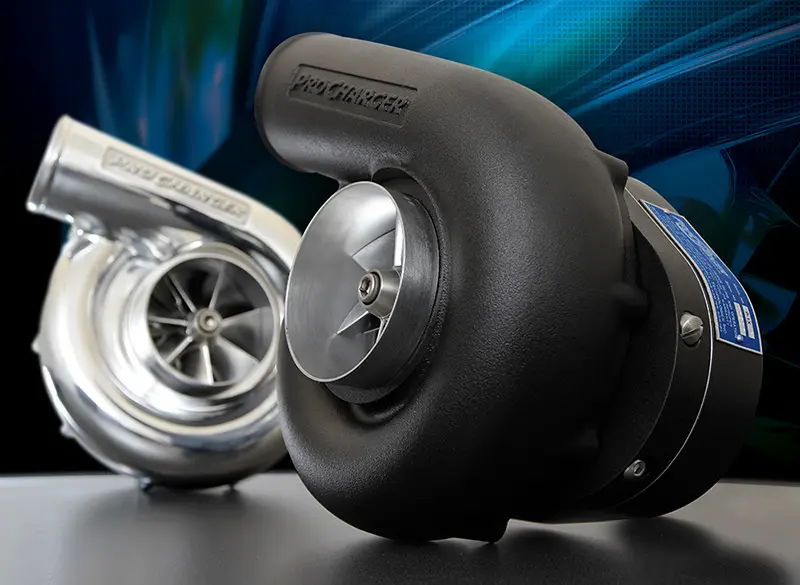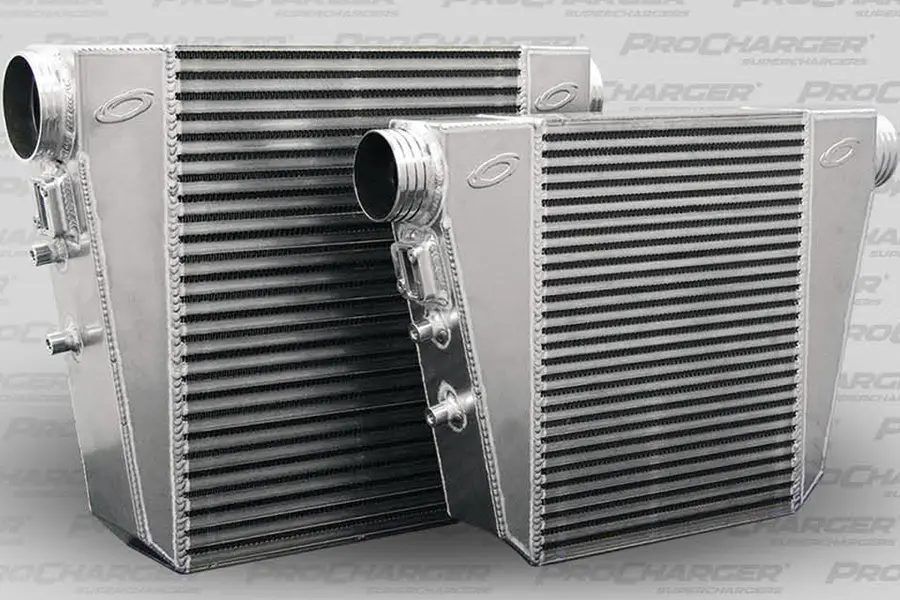
WHAT IS A SUPERCHARGER
PROCHARGER 101
Want to know more about supercharging and, specifically, the ProCharger geared centrifugal superchargers? Read on, as we cover topics from from power generation to intercooling in what we call “ProCharger 101.”
What is a supercharger?
A supercharger is a mechanical device that increases an internal combustion engine’s power output by forcing more air into the combustion chamber, allowing for more fuel to be burned and creating a more powerful explosion. Unlike turbochargers which are powered by exhaust gases, superchargers are directly connected to the engine’s crankshaft through belts, chains, or gears, providing immediate power delivery without lag.
How Superchargers Work
At its core, a supercharger is an air compressor that increases the pressure and density of air supplied to an internal combustion engine. By forcing more air into the combustion chamber, the engine can burn more fuel, resulting in a more powerful explosion during each cycle. This process significantly boosts the engine‘s horsepower and torque output.
Unlike turbochargers, which harness energy from exhaust gases, superchargers draw their power directly from the engine’s crankshaft. This mechanical connection typically uses a belt, chain, or gear system. When the engine runs, it spins the supercharger, which then compresses incoming air before delivering it to the intake manifold.
The compression process generates heat, which can reduce air density and limit power gains. To counter this, ProCharger systems incorporate an intercooler—a heat exchanger that cools the compressed air before it enters the engine. Cooler air is denser, containing more oxygen molecules per volume, which allows for more efficient combustion and greater power output.
WHAT'S THE DEAL WITH BOOST?
“Boost” is the generic term for air that has been compressed by a supercharger above atmospheric pressure and forced into the engine, hence why it can also be called “Forced Induction.”
Superchargers for street use typically have a boost pressure of 6 to 12 pounds per square inch (psi) above atmospheric pressure. At sea level, atmospheric pressure is 14.7 psi, so adding that additional boost pressure represents approximately a 50-85% increase in air delivery to the engine. Adding more air allows you to add more fuel, which translates to substantial power gains.
Thanks to “boost” customers can enjoy massive increases in horsepower, without the hassle of changing internal engine components, which is why supercharging is also commonly referred to as “bolt-on” performance.
Types of Superchargers
There are three primary types of superchargers used in automotive applications, each with distinct characteristics and performance profiles.
Roots-Type Superchargers
The Roots-type supercharger is the oldest design, dating back to 1860 when it was initially created for mine shaft ventilation. This positive displacement supercharger features two counter-rotating lobes that trap air between them and the housing, pushing an additional volume of air into the intake manifold without actually compressing the air.
Roots superchargers are typically mounted directly on top of the engine, and often feature the distinctive, large component that protrudes through the hood in many drag racing cars. They deliver boost across the RPM range. However, they tend to be less efficient at higher RPMs compared to other designs and can generate significant heat.
Twin-Screw Superchargers
Twin-screw superchargers (also called Lysholm superchargers) use two interlocking screws to compress and move air. As air travels through the increasingly narrow passages between the screws, it becomes compressed before delivery to the intake manifold.
This design offers higher thermal efficiency than Roots-type superchargers because compression occurs internally rather than against pressure in the intake manifold.
Centrifugal Superchargers
Centrifugal superchargers resemble turbochargers in design but are mechanically driven rather than exhaust-powered. They use an impeller spinning at high speeds to draw in air and accelerate it outward, converting velocity into pressure.
Unlike positive displacement superchargers (Roots and twin-screw), centrifugal superchargers produce boost that increases proportionally with engine speed. This progressive boost delivery makes them feel more like a naturally aspirated engine with enhanced power at higher RPMs. Their compact design allows for easier installation in tight engine compartments, and they typically generate less heat than other supercharger types.
WHAT IS A PROCHARGER?
ProCharger’s self-contained (SC) supercharger models are the first gear-driven centrifugal superchargers to feature self-lubrication, and contain the industry’s most advanced supercharging technology. In addition to the patented self-contained oiling design, ProChargers also feature the highest step-up ratio, exclusive billet impellers, and the industry’s only billet gearcases for superior rigidity, sealing and appearance. Learn more about ProCharger’s technological advantages and our product lines – High Output vs. Stage II and Complete Systems vs. Tuner Kits.
Not sure what a centrifugal supercharger is? Check out ProCharger’s detailed breakdown on centrifugal superchargers and learn where your boost starts.

Supercharger vs. Turbocharger
While both superchargers and turbochargers are forced induction systems that increase engine power, they differ significantly in operation, performance characteristics, and driving experience.
The fundamental difference lies in their power source. Superchargers draw power directly from the engine’s crankshaft, creating an immediate but constant power drain. Turbochargers, conversely, are powered by exhaust gases that would otherwise be wasted, making them potentially more efficient but subject to “turbo lag”—the delay between throttle input and boost delivery as the turbine spools up.
Superchargers provide instant throttle response and linear power delivery throughout the RPM range. This immediate boost makes them particularly desirable in applications where responsiveness is crucial, such as drag racing or quick street acceleration. The direct mechanical connection ensures that boost is available as soon as the engine is running, even at idle or low RPMs. It also simplifies the tuning process and minimizes installation efforts.
Turbochargers, while potentially more fuel-efficient, typically exhibit a noticeable lag before delivering full boost. Once spooled up, turbochargers can provide equivalent power, but potentially improved fuel economy, over a supercharger due to the supercharger’s power draw from the crankshaft.
Benefits of Supercharging
Supercharging offers several distinct advantages that make it an attractive option for performance enhancement:
- First and foremost is the significant power increase. A properly designed supercharger system can boost engine output by 50-85% or more, dramatically improving acceleration and top speed without the need for extensive engine modifications.
- The immediate throttle response is another major benefit. Unlike turbochargers, which require time to spool up, superchargers deliver boost instantly, providing a more direct connection between the driver’s foot and the engine’s output. This responsiveness creates a more engaging driving experience, particularly in performance-oriented cars.
- Superchargers also maintain consistent performance at varying altitudes. As elevation increases, air density decreases, reducing engine power in naturally aspirated engines. Superchargers compensate for this by compressing the thinner air, helping maintain sea-level-like performance even at high elevations.
- The predictable, linear power delivery of supercharged engines makes them easier to tune and control in high-performance driving situations. This characteristic is particularly valuable in racing applications where consistent, predictable power is essential for maintaining control and optimizing lap times.
Superchargers in Modern Vehicles
As engine and transmission technology from automotive manufacturers has evolved over the years, so has supercharger technology.
Modern supercharger systems feature advanced aerodynamics that optimize both performance and efficiency. Materials science has contributed lighter, stronger components that reduce parasitic losses while handling higher boost pressures.
For centrifugal superchargers
INTERCOOLING TECHNOLOGY
It’s a simple fact of physics: cooler air makes more power. On street driven vehicles, air-to-air intercooling is a natural fit because it locates the intercooler at the front of the vehicle where it is exposed to a constant supply of cooling airflow. Experts agree that air-to-air inherently provides better cooling and reliability than air-to-water intercoolers for street use. Engineered with large-volume air plenums, ProCharger’s air-to-air intercoolers utilize a highly effective and extremely durable bar and plate intercooler core design that provides large surface areas for superior levels of heat dispersion.

PROCHARGER 101 YOUTUBE SERIES
ProCharger 101 is here to help with basic information/instructions about our products. Follow along and don’t forget to like and subscribe!
EMISSIONS COMPLIANCE
ProCharger offers Executive Orders for Emissions Compliance (EO) from California Air Resources Board (CARB) for many of our most popular car, truck and SUV applications. If you live in California, we can only sell you products with EO certification. Check out our full list of EO offerings.

